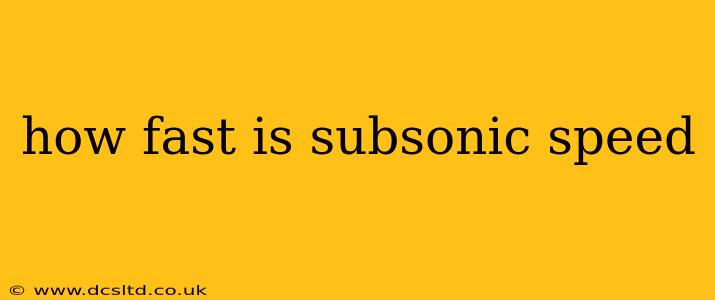Subsonic speed refers to any speed slower than the speed of sound. But what exactly is the speed of sound, and how does that translate into practical terms? This comprehensive guide will delve into the intricacies of subsonic speeds, exploring its definition, variations, and applications.
What is the Speed of Sound?
The speed of sound isn't a fixed constant; it varies depending on the medium through which it travels. Most commonly, we discuss the speed of sound in air, and even then, it changes with factors like temperature, humidity, and air pressure. Generally, at sea level and a temperature of 68°F (20°C), the speed of sound in air is approximately 767 miles per hour (mph), or 1235 kilometers per hour (km/h), or 343 meters per second (m/s).
How Does Temperature Affect the Speed of Sound?
As temperature increases, the molecules in the air move faster, leading to faster transmission of sound waves. For every degree Celsius increase in temperature, the speed of sound increases by roughly 0.6 m/s. This means that on a hot summer day, the speed of sound will be slightly faster than on a cold winter day. Conversely, colder temperatures result in slower sound speeds.
What is Considered Subsonic Speed?
Any speed below the speed of sound in a given medium is considered subsonic. Therefore, a car driving at 60 mph, a passenger plane cruising at 500 mph, or even a gentle breeze are all examples of subsonic speeds. The critical factor is that these speeds remain below the local speed of sound.
How Does Subsonic Flight Work?
Subsonic flight is the most common type of air travel, with aircraft operating well below the sound barrier. These aircraft are designed to generate lift at these speeds, using airfoils shaped to create the necessary pressure differences. The design considerations for subsonic aircraft differ significantly from those of supersonic aircraft, which must cope with the significant aerodynamic challenges posed by approaching and exceeding the speed of sound.
What are the Applications of Subsonic Technology?
Subsonic technology has broad applications across various fields:
- Aviation: Most commercial airplanes operate at subsonic speeds, prioritizing fuel efficiency and passenger comfort.
- Automotive: All cars and most other land-based vehicles operate at subsonic speeds.
- Meteorology: Understanding subsonic wind speeds is crucial for weather forecasting and analysis.
- Acoustics: The study of sound propagation in subsonic ranges is fundamental to various fields like architecture, music, and noise control.
What is the Difference Between Subsonic, Transonic, Supersonic, and Hypersonic?
These terms describe different speed regimes relative to the speed of sound:
- Subsonic: Slower than the speed of sound.
- Transonic: Speeds approaching and around the speed of sound. This range presents unique aerodynamic challenges.
- Supersonic: Faster than the speed of sound.
- Hypersonic: Significantly faster than the speed of sound (typically five times or more).
How is Subsonic Speed Measured?
Subsonic speed, like any speed, is measured in units of distance per unit of time. Common units include:
- Miles per hour (mph)
- Kilometers per hour (km/h)
- Meters per second (m/s)
- Knots (nautical miles per hour)
The choice of units depends on the context; for example, aviation often uses knots, while automotive applications typically utilize mph or km/h.
Is there a maximum subsonic speed?
Yes, the maximum subsonic speed is, by definition, the speed of sound in the given medium. Any speed above this is considered supersonic. This speed varies with the conditions described earlier.
This exploration of subsonic speeds clarifies its definition, variations, and real-world applications. Understanding the nuances of sound propagation and speed regimes is essential across numerous scientific and engineering disciplines.
